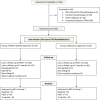Structured Total Knee Replacement Rehabilitation Programme and Quality of Life following Two Different Surgical Approaches - A Randomised Controlled Trial
- PMID: 31467647
- PMCID: PMC6702978
- DOI: 10.5704/MOJ.1907.004
Structured Total Knee Replacement Rehabilitation Programme and Quality of Life following Two Different Surgical Approaches - A Randomised Controlled Trial
Abstract
Introduction: The key important factor influencing the outcomes following rehabilitation is the surgical approach involved in Total Knee Replacement (TKR). Most studies have analysed the functional outcome in comparing the approaches on surgical perspective rather on post-operative therapeutic interventions. The current study was to analyse the effects of structured TKR rehabilitation programme on the quality of life and joint specific outcomes between two different surgical approaches. Materials and Methods: In this double-blind randomised controlled trial, participants were randomly allocated to one of two groups: Group 1- those who underwent medial parapatellar approach and Group 2- those who underwent mid-vastus approach. Both groups received three-phase structured rehabilitation protocol for 12 weeks. The outcome measures of SF-36, knee mobility, isometric knee musculature strength and six-minute walk distance were measured at baseline, on discharge and at review after three months. Results: The quality of life and joint specific outcome scores were better in mid-vastus approach than the popular medial parapatellar approach. The outcomes of knee flexion mobility (p=0.04), knee extension mobility (p=0.03), isometric muscle strength of quadriceps (p=0.001), isometric muscle strength of hamstrings (p=0.03), six-minute walk distance (p=0.001) and Physical Cumulative Scores (PCS) (p=0.03) were found to exhibit significant improvements at three months follow up. Conclusion: The mid-vastus approach was found to exhibit better improvements following structured rehabilitation care, in physical summary scores of quality of life and joint specific outcomes than medial parapatellar approach.
Keywords: arthroplasty; medial parapatellar approach; mid-vastus approach; outcomes; physiotherapy care.
References
-
- Bathis H, Perlick L, Blum C, Luring C, Perlick C, Grifka J. Midvastus approach in total knee arthroplasty: a randomized, double-blinded study on early rehabilitation. Knee Surg Sports Traumatol Arthrosc. 2005;13:545–50. - PubMed
-
- Dalury DF, Snow RG, Adam MJ. Electromyography evaluation of the midvastus approach. J Arthroplasty. 2008;23(1):136–40. - PubMed
-
- Maru M, Akra GA, McMurtry I, Port A. A prospective comparative study of the midvastus and medial parapatellar approaches for total knee arthroplasty in the early postoperative period. Eur J Orthop Surg Traumatol. 2009;19(7):473–6.
-
- Shukla R, Mahajan P, Singh M, Jain RK, Kumar R. Outcome of Total Knee Replacement via Two Approaches in Indian Scenario. J Knee Surg. 2017;30(2):174–8. - PubMed
-
- Moffet H, Collet JP, Shapiro SH, Paradis G, Marquis F, Roy L. Effectiveness of Intensive Rehabilitation on Functional Ability and Quality of Life after First Total Knee Arthroplasty: A Single-Blind Randomized Controlled Trial. Arch Phys Med Rehabil. 2004;85:546–56. - PubMed
LinkOut - more resources
Full Text Sources
Medical

